So you’re ready to grow your own chestnut trees, or maybe you already have a few in the backyard. Do you know how to keep them healthy, producing sizable yields of nuts each year when they reach maturity?
Insects, as well as some larger visitors to your garden, may enjoy feasting on the tasty nuts, wood, or leaves. Or perhaps they’re after a cozy place to lay their eggs. But what’s a home orchardist to do?
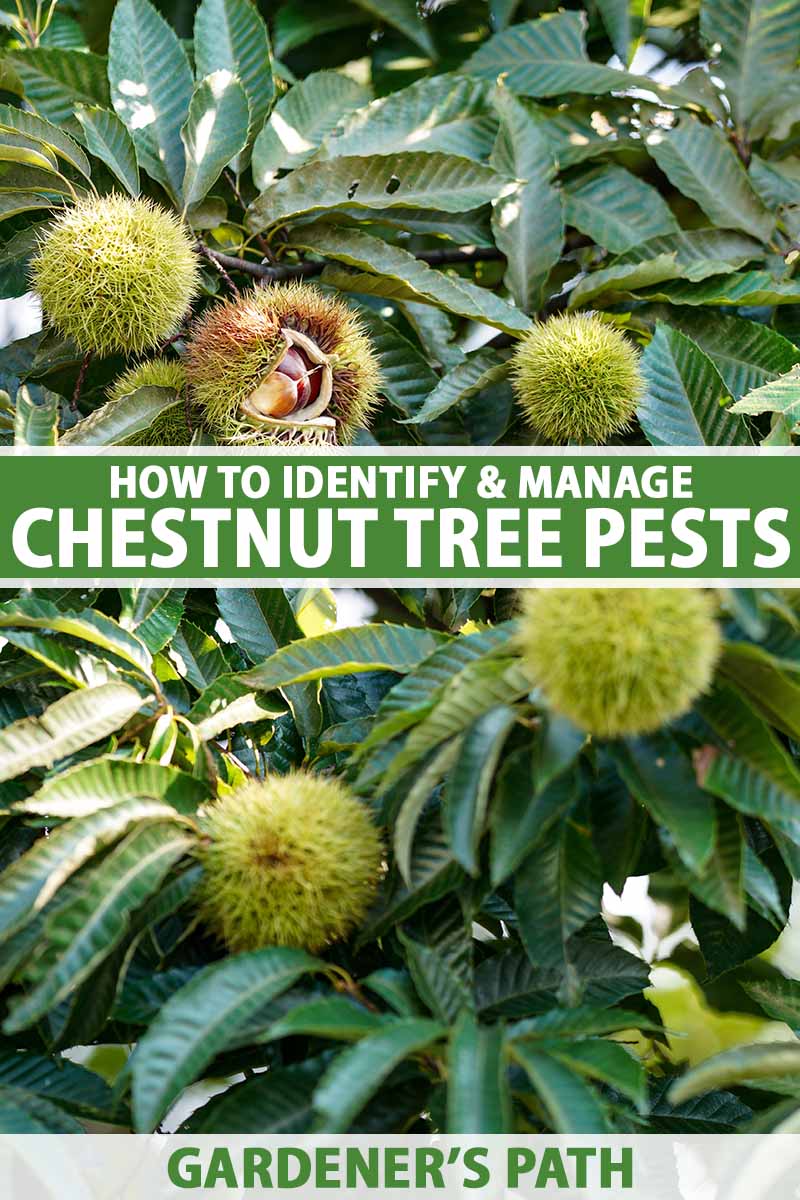
We link to vendors to help you find relevant products. If you buy from one of our links, we may earn a commission.
We cover the basics in our guide to growing chestnuts.
Here, we’ll go over the most common pests in a bit more detail so you’ll know what to be on the lookout for, with tips for preventing and mitigating damage and infestations.
5 Common Chestnut Tree Pests
1. Larger Herbivores and Omnivores
Deer can cause a lot of problems, since they love to munch on the sweet nuts. So do squirrels, chipmunks, wild turkeys, bears… the list goes on and on! And deer may take a bite or two out of saplings as well.
The best thing to do is to install protective and effective fencing around your garden to stop the deer and other animals from getting in in the first place, especially when your trees are young and vulnerable.
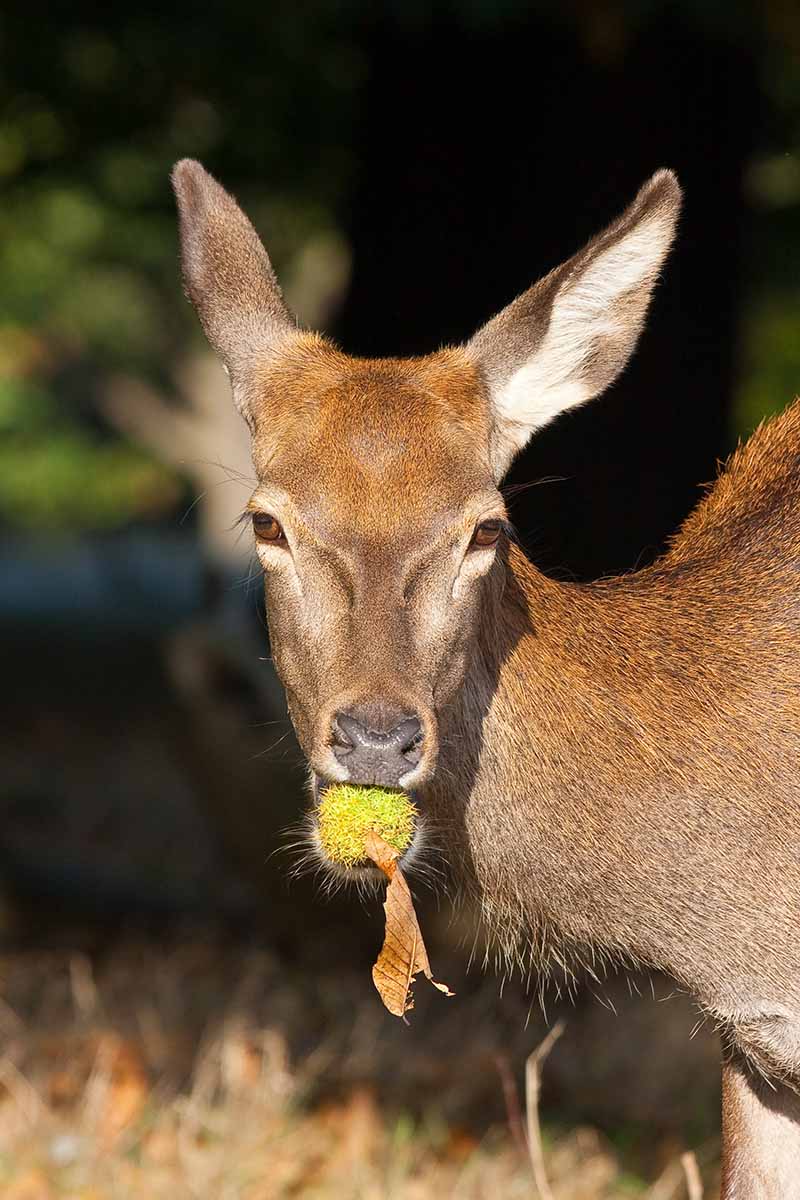
Wire cages may also be used around the trees, or electric fences. There are also a number of deer repellents on offer, but keep in mind that these have to be applied regularly to be effective, and this can become a bit time-consuming for backyard growers.
Likewise, many varieties of birds and rodents can be a bit of a nuisance as they like these nuts just as much as humans do, if not more, in some cases.
You could opt to erect a wire cage-type shelter around small trees to guard against cheeky chestnut-stealing animals. But this will not work for larger trees.
Instead, be sure to harvest quickly and often when the chestnuts begin to fall, to save as much of the crop as you can for yourself.
2. Aphids
These trees are vulnerable to aphid attacks, especially the European or sweet variety (Castanea sativa), which is particularly bothered by the sweet chestnut aphid (Myzocallis castanicola).
Luckily, infestations rarely have enough of an effect on the trees to require treatment.
Small saplings inundated with a large infestation can be sprayed with a strong stream of water from the hose to dislodge the sap-sucking beasts.
You can read more about dealing with aphids in the garden in our guide.
3. Asian Chestnut Gall Wasps
Considered the most significant pest of chestnuts throughout the world, larvae of the Asian chestnut gall wasp (Dryocosmus kuriphilus) create galls on the leaves and buds of these trees.
Introduced accidentally to the US in 1974, this pest was first detected in Georgia on an imported Chinese chestnut (C. mollissima).
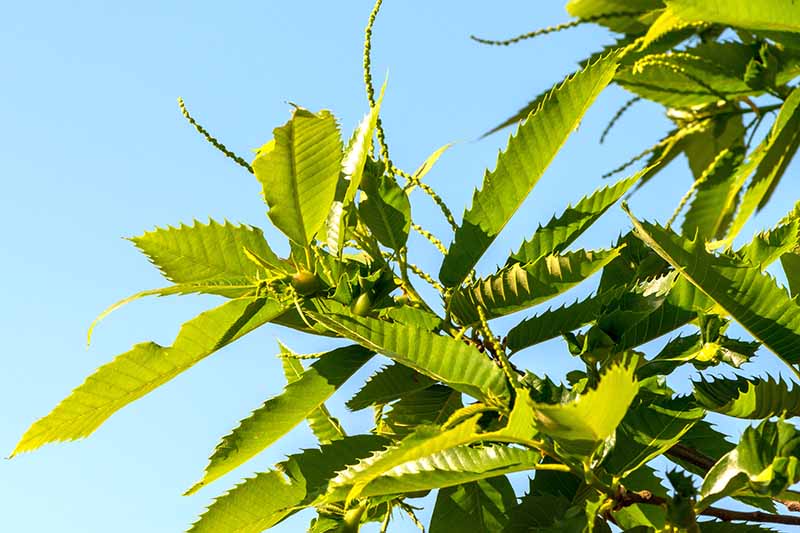
Gaining a wide spread in the US since the ‘70s, this tiny wasp is known to occur today in Georgia, Alabama, North Carolina, Tennessee, Virginia, Kentucky, Ohio, Maryland, and Pennsylvania. It was first detected in Europe in the early 2000s, and has spread significantly there in the intervening years.
Small white larvae measuring about two and a half millimeters in length hatch out of even tinier white eggs.
The adult female wasps aren’t much larger, about two and a half to three millimeters long, with black bodies, orange to brown legs, and translucent wings. Reproduction occurs without mating, and the unfertilized eggs develop into female clones.
When the adults emerge in the summer, they lay their eggs inside the developing buds of chestnut trees, sometimes more than 100 eggs per adult. The eggs hatch in 30 to 40 days, and the first instars overwinter inside the buds.
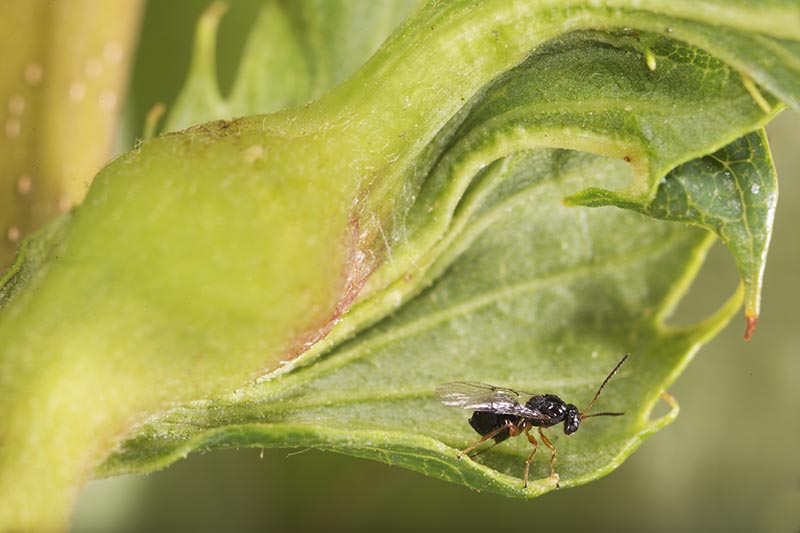
At bud burst, green or pink galls are formed, each of which can contain several larvae. The larvae remain inside the galls for about 50 days, and the adults emerge through exit holes that they make in the galls in June or July.
The galls become dry, woody, and brown, and they can remain on the trees for several years.
These pests can cause significant reductions in yields, and infestations can cause bud and flower drop, inhibit photosynthesis, and lead to twig dieback. Severe infestations can kill trees, or leave them more susceptible to secondary infections such as chestnut blight.
Early detection is the best course of management, and growers can check their trees for signs of galls in the spring and destroy affected plant matter if they are able to. Of course, if the trees are tall, this may prove difficult if not impossible.

Since the larvae are protected within the galls and the canopies of chestnuts are often towering high overhead, chemical controls are mostly ineffective as well.
Some efforts have been made to breed resistant trees, including a European-Japanese hybrid called ‘Bouche de Bétizac.’ And introducing the parasitoid chalcid wasp Torymus sinensis has proven highly effective; however, the future environmental impact of this form of biological control remains unknown.
Regulated as a quarantined pest in some parts of the world, contact your local extension agent for recommendations if you detect its presence.
4. Two-Lined Chestnut Borers
You may also come across the two-lined chestnut borer (Agrilus bilineatus), a variety of wood-boring jewel beetle.
These beetles were once primary pests of American chestnut trees (C. dentata), and today species of oak serve as their primary hosts. This pest prefers to infest trees that are already weakened by disease or stressed, though this is not always the case.
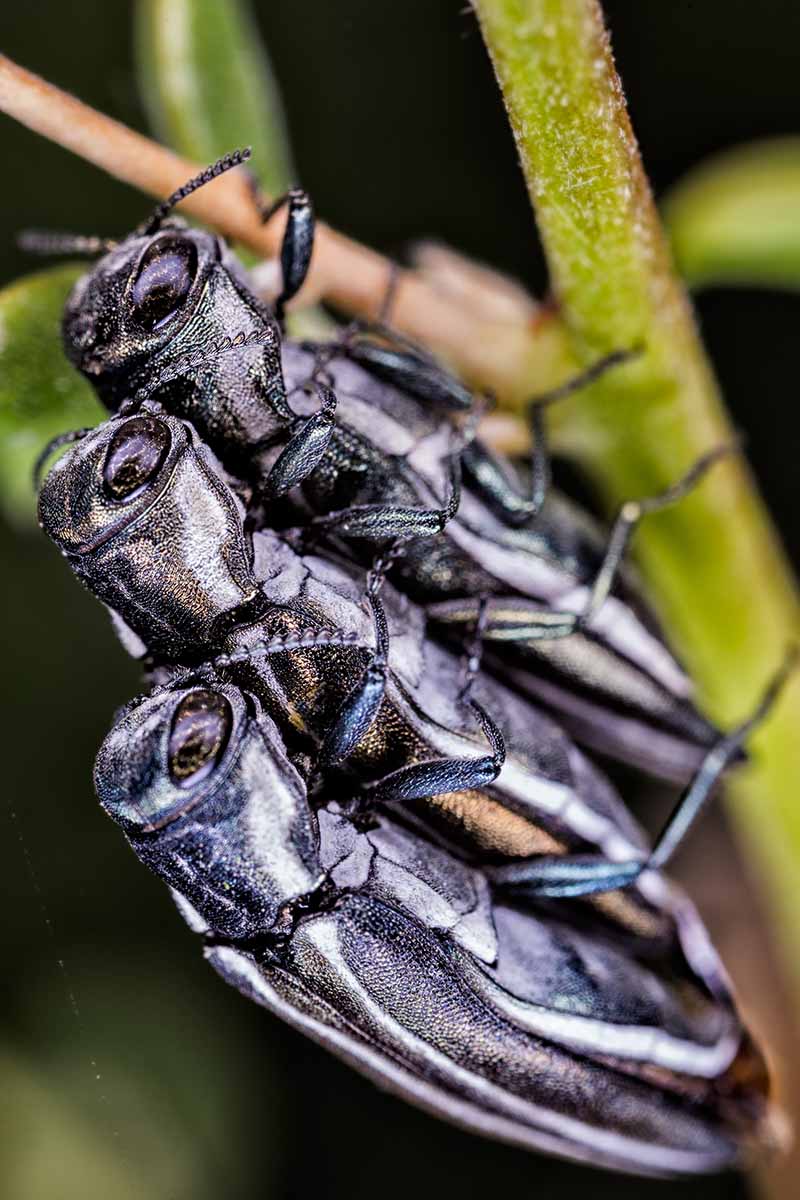
The adult beetles are under half an inch long, slender and black with a light yellow stripe on each wing cover. Active in late spring and summer, adults feed on leaves at the tops of the trees before laying their eggs in cracks and crevices in the bark.
The larvae that hatch are white and about an inch long, with two spines on the posterior end.
These grubs dig winding mines through the inner bark and outer sapwood of trees, often girdling them, and progressing from the tops of the trees downwards. The damage they cause can lead to dieback, and the eventual death of infested trees.
After the larvae pupate, adult beetles emerge through D-shaped holes in the bark, but these can be hard to spot.
Insecticides are often used preventively by commercial growers, but the best course of action for the home gardener is to provide the best possible care to their trees to avoid infestation. Healthy trees are much less susceptible.
5. Weevils
Weevils are worrisome for these trees. Larvae residing in the nuts are ready to chew their way out by the time they hit the ground in the fall, causing considerable crop losses.
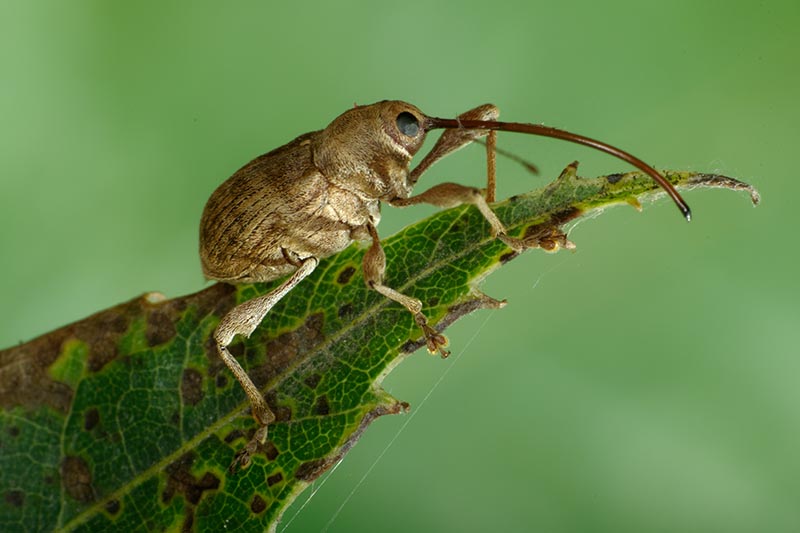
The lesser or small chestnut weevil (Curculio sayi) and the large or great chestnut weevil (Curculio caryatrypes) in particular are the most common weevil pests of these trees, though they are known to infest only American and Chinese chestnuts.
Emerging from the ground in late spring and early summer, adult C. sayi weevils lay their eggs in the fall, when the nuts are nearly mature. Laid in the inner membrane covering the nuts after the burrs have cracked, they hatch in about 10 days.
A few weeks later, after the nuts fall to the ground, the larvae chew their way out and burrow into the soil.
Completing their life cycle over the course of several years, the grubs continue to develop in the soil through two winters, typically spending another winter underground as adults before emerging.
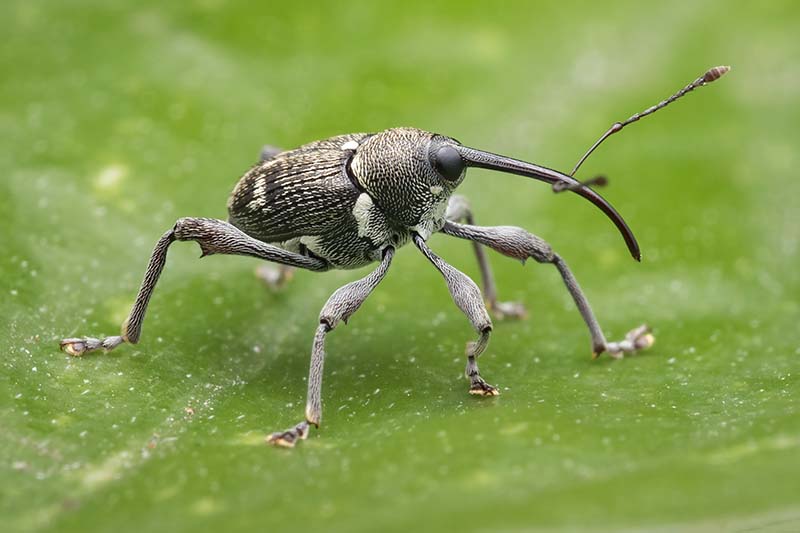
C. caryatrypes adults emerge later, in midsummer, laying their eggs soon after. These hatch in five to seven days, and within a few weeks, they chew their way out of the nuts and drop to the ground, typically before the nuts fall.
Overwintering in the soil, the larvae pupate and emerge as adults the following summer, though some may overwinter for a second year.
Good sanitation is the healthiest, most ecologically friendly way to deal with weevils.
This means harvesting directly off of the trees if you’re able to – though you probably won’t be, once your trees reach their mature size – and collecting fallen nuts daily, before the larvae can escape into the ground.
Any infested nuts can then either be disposed of in the trash or burned, if this is permitted in your area.
Beneficial nematodes may also prove effective against weevil grubs.
Tell Pesky Pests to Leave Your Chestnuts Alone!
Well, that about covers it – the top pests you may encounter, with a few suggestions for preventing and managing infestations.
Sorry to disappoint, if you were hoping for better solutions to deal with some of these. The truth is, eradicating small insect pests or keeping birds and other types of wildlife away from your enticing nut trees altogether isn’t often feasible.
But as part of a healthy ecosystem where the trees are well cared for and their needs are met, chestnuts grown today should prove less susceptible to a variety of common insect pests.
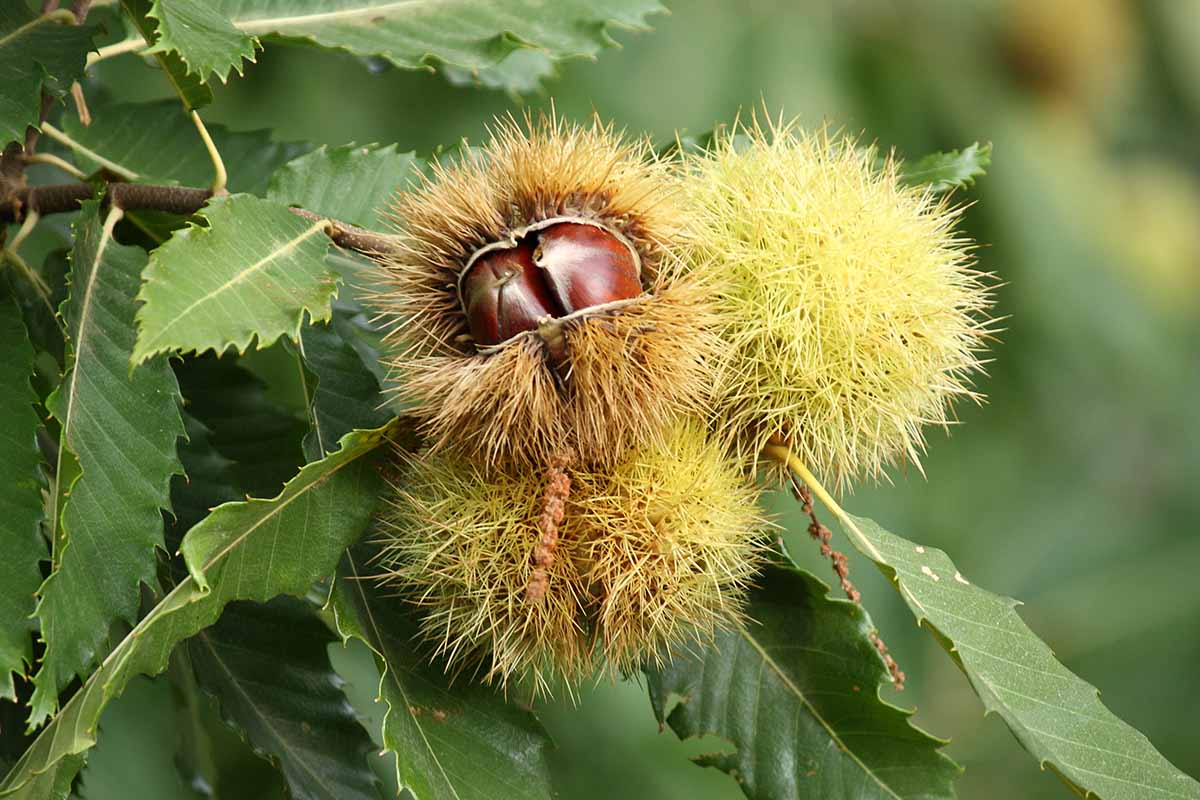
With enough sunlight and water, attentive maintenance and harvesting, and appropriate cleanup at the end of the season, you’ll give your trees the best chance of avoiding or withstanding a pest infestation.
Have you encountered any of these common foes? How did you deal? Share your stories and questions in the comments below.
And for more information on growing your own nut trees at home, read these guides next: